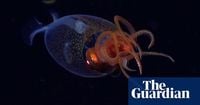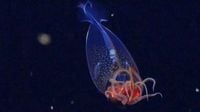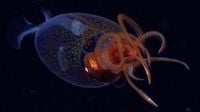In a groundbreaking discovery, scientists have captured the first-ever footage of a live colossal squid in its natural habitat, marking a significant milestone in marine biology. This remarkable event took place on March 9, 2025, during a 35-day expedition near the South Sandwich Islands in the South Atlantic Ocean, led by the Schmidt Ocean Institute.
The colossal squid, scientifically known as Mesonychoteuthis hamiltoni, is the largest invertebrate on the planet, capable of growing up to 23 feet (7 meters) in length and weighing as much as 1,100 pounds (500 kg). However, the specimen filmed was a juvenile, measuring just 11.8 inches (30 cm). This young squid showcased its transparent body and eight pink tentacles, captivating the researchers who witnessed it.
Dr. Michelle Taylor, chief scientist of the expedition, expressed her amazement at the sighting. "It’s exciting to see the first in situ footage of a juvenile colossal and humbling to think that they have no idea that humans exist," she remarked. The footage was captured at a depth of 1,968 feet (600 meters) using the remotely operated vehicle (ROV) named SuBastian, which was livestreaming the event.
Prior to this expedition, the colossal squid had only been documented in the stomachs of sperm whales and through dying adults spotted near the surface. The first specimens were described in 1925, based on remains found in the stomachs of hunted sperm whales. Dying adults have been filmed before, but this sighting represents the first time a live specimen has been observed at depth.
During the expedition, the team initially did not recognize the significance of the squid they were filming. "At the time, not being a squid expert and regrettably having none on board the ship, we did not realize that we had seen a colossal squid," Dr. Taylor explained. It was only later, upon review by experts including Dr. Kat Bolstad and Dr. Aaron Evans, that the identity of the squid was confirmed.
Dr. Bolstad noted the importance of this sighting, emphasizing, "For 100 years, we have mainly encountered them as prey remains in whale and seabird stomachs and as predators of harvested toothfish." The footage not only provides a glimpse into the life of this elusive species but also raises questions about its life cycle and behavior.
The colossal squid is a member of the glass squid family, known for its transparent appearance in juvenile stages. As they mature, they lose this transparency, making it difficult to study their biology and ecology. Dr. Taylor highlighted the significance of observing a live specimen, stating, "For example, see how it holds itself in the water column, how it moves, its behaviors – none of this is possible with dead specimens."
This discovery comes on the heels of another significant finding, as earlier in January 2025, researchers captured footage of the glacial glass squid (Galiteuthis glacialis) in the Southern Ocean near Antarctica, marking another first for marine biology.
Dr. Jyotika Virmani, executive director of the Schmidt Ocean Institute, commented on the recent expeditions, stating, "The first sighting of two different squids on back-to-back expeditions is remarkable and shows how little we have seen of the magnificent inhabitants of the Southern Ocean." She added, "These unforgettable moments continue to remind us that the ocean is brimming with mysteries yet to be solved."
The colossal squid's unique features include rotating hooks at the ends of its tentacles, which distinguish it from other squid species. Dr. Evans, who was part of the verification team, expressed his excitement during a press briefing, saying, "When we saw the arm hooks, I started hyperventilating."
Historically, the colossal squid has been elusive, with most encounters occurring post-mortem. The largest recorded colossal squid was captured in 2007 by a New Zealand fishing boat, but it was already dying when caught. This new footage not only provides a rare opportunity to study the squid in its natural habitat but also raises awareness about the vast and largely unexplored ocean depths.
The ocean remains one of the least understood environments on Earth, with only about 20% of the ocean floor sufficiently mapped as of 2025. This reality emphasizes the importance of continued exploration and research in marine biology.
As scientists continue to uncover the mysteries of the deep sea, the footage of the colossal squid serves as a reminder of the wonders that still await discovery. The ocean, often referred to as the final frontier, holds countless secrets, and each expedition brings us closer to understanding its inhabitants.
In summary, the filming of the juvenile colossal squid marks a historic moment in marine research, providing valuable insights into one of the ocean's most enigmatic creatures. As exploration efforts continue, the hope is that more discoveries will shed light on the lives of these magnificent beings.








